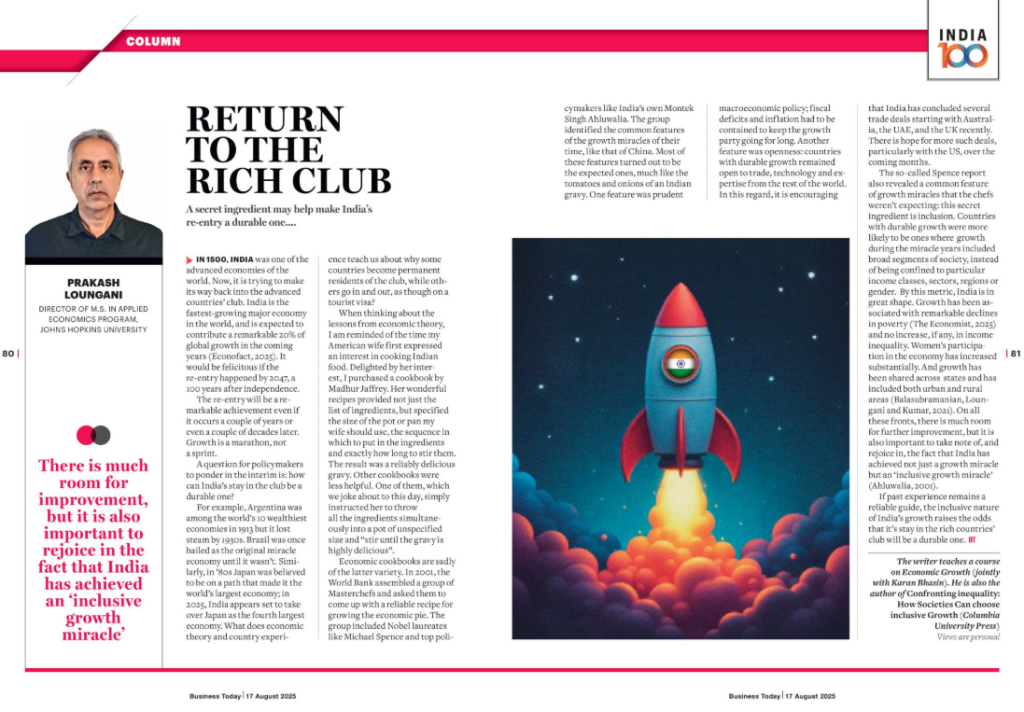Tuesday, August 12, 2025
Return to the Rich Club: A secret ingredient may help make India’s re-entry a durable one…
This article first appeared in the India@100 special issue of Business Today. Here is a link to the image of the article. The full text is provided below:
In 1500, India was one of the advanced economies of the world. Now, it is trying to make it way back into the advanced countries’ club. India is the fastest-growing major economy in the world, and is expected to contribute a remarkable 20 percent of global growth in the coming years (Econofact, 2025). It would be felicitous if the re-entry happened by 2047, a 100 years after independence.
But re-entry will be a remarkable achievement even if it occurs a couple of years or even a couple of decades later. Growth is a marathon race, not a sprint.
A question for policymakers to ponder in the interim is: how can India’s stay in the club be a durable one? What does economic theory and country experience teach us about why some countries become permanent residents of the club, while others go in and out, as though on a tourist visa?
When thinking about the lessons from economic theory, I am reminded of the time my American wife first expressed an interest in cooking Indian food. Delighted by her interest, I purchased a cookbook by Madhur Jaffrey. Her wonderful recipes provided not just the list of ingredients, but specified the size of the pot or pan my wife should use, the sequence in which to put in the ingredients and exactly how long to stir them. The result was a reliably-delicious gravy. Other cookbooks were less helpful. One of them, which we joke about to this day, simply instructed her to throw all the ingredients simultaneously into a pot of unspecified size and “stir until the gravy is highly delicious”.
Economic cookbooks are sadly of the latter variety. In 2001, the World Bank assembled a group of Masterchefs and asked them to come up with a reliable recipe for growing the economic pie. The group included Nobel laureates like Michael Spence and top policymakers like India’s own Montek Singh Ahluwalia. The group identified the common features of the growth miracles of their time, like that of China. Most of these features turned out to be the expected ones, much like the tomatoes and onions of an Indian gravy. One feature was prudent macroeconomic policy; fiscal deficits and inflation had to be contained to keep the growth party going for long. Another feature was openness: countries with durable growth remained open to trade, technology and expertise from the rest of the world.
But the so-called Spence report also revealed a common feature that the chefs weren’t expecting: this secret ingredient is inclusion. Countries with durable growth were more likely to be ones where growth during the miracle years included broad segments of the society, instead of being confined to particular income classes, sectors, regions or gender. By this metric, India is in great shape. Growth has been associated with remarkable declines in poverty (The Economist, 2025) and no increase, if any, in income inequality. Women’s participation in the economy has increased substantially. and growth has been shared across states and has included both urban and rural areas (Balasubramanian, Loungani and Kumar, 2021). On all these fronts, there is much room for further improvement, but it is also important to take note of, and rejoice in, the fact that India has achieved not just a growth miracle’ but an ‘inclusive growth miracle’ (Ahluwalia, 2001).
If past experience remains a reliable guide, the inclusive nature of India’s growth raises the odds that its’ stay in the rich countries’ club will be a durable one.
The author is the Director of the M.S. in Applied Economics program at Johns Hopkins University, where he teaches a course on Economic Growth (jointly with Karan Bhasin). He is the author of Confronting inequality: How Societies Can choose inclusive Growth (Columbia University Press, 2019).

Posted by at 2:52 PM
Labels: Inclusive Growth
Subscribe to: Posts